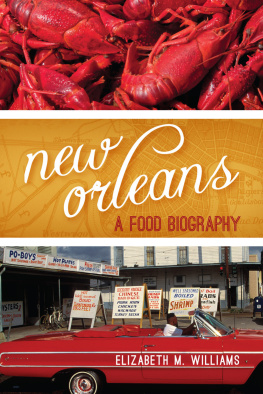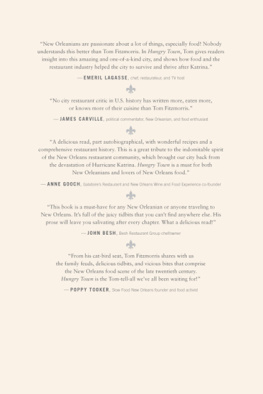

Published in 2010 by Stewart, Tabori & Chang
An imprint of ABRAMS
Copyright 2010 by Tom Fitzmorris
All rights reserved. No portion of this book may be reproduced, stored in a retrieval system, or transmitted in any form or by any means, mechanical, electronic, photocopying, recording, or otherwise, without written permission from the publisher.
The Library of Congress has cataloged the original edition as follows:
Fitzmorris, Tom, 1951
Tom Fitzmorriss [sic] New Orleans food : more than 225 of the citys best recipes to cook at home / by Tom Fitzmorris.
p. cm.
Includes bibliographical references and index.
ISBN 1-58479-524-7
1. Cookery, AmericanLouisiana style. 2. CookeryLouisianaNew Orleans. I. Title: New Orleans food. II. Title: Tom Fitzmorriss New Orleans food. III. Title: Tom Fitzmorris New Orleans food. IV. Title.
TX715.2.L68F584 2006
641.59763dc22
2005030811
ISBN for this edition: 978-1-58479-876-7
Produced for Stewart, Tabori & Chang by
gonzalez defino
New York, New York
www.gonzalezdefino.com
EDITORIAL DIRECTOR Joseph Gonzalez
ART DIRECTOR Perri DeFino
EDITOR Julia Lee
COPYEDITOR Marilyn Knowlton
PRODUCTION MANAGER Jane Searle
Stewart, Tabori & Chang books are available at special discounts when purchased in quantity for premiums and promotions as well as fundraising or educational use. Special editions can also be created to specification. For details, contact specialsales@abramsbooks.com or the address below.

115 West 18th Street
New York, NY 10011
www.abramsbooks.com

Contents
Authors Note
O n Monday, August 29, 2005, one of the most vital and important capitals of the culinary world came to a complete and abrupt halt. Hurricane Katrina, the most destructive storm in the history of the United States, shut down all of the restaurants in New Orleans and those within a hundred miles in every direction. The population of the entire metropolitan areaabout a million and a half peoplewas told to evacuate.
The storm did unimaginable damage to the Mississippi Gulf Coast, destroying man-made structures right down to roads and slabs. In New Orleans, the damage from the storms winds was less severe. But the storm came in at the perfect angle to blow a deluge of water from Lake Pontchartrain through breaks in the levees into the city. The levees had always protected the city before, but theyd never faced a storm like this one. Eighty percent of the city was flooded, in some places more than 10 feet deep. Hundreds of people died, and many were displaced.
Im writing this note three weeks after the storm. About half of the city is still flooded as the worlds largest drainage pumping station labors to send the water back to where it came from. Most of the area is still evacuated. No restaurants have reopened, although many of them are making plans, usually for weeks to months from now.
I am still in evacuation myself. I know that my home is okay and that my family is safe. So Im better off than a substantial percentage of my fellow Orleanians, many of whom are in temporary shelters in cities across America. My worst problem is that my occupation since collegewriting and broadcasting about New Orleans restaurants and foodis, at best, compromised.
I cant stand to do nothing. So while waiting to return, I put the finishing touches on this collection of what I think are the best recipes from my three decades of reporting on Creole and Cajun cuisines. Until our city is healthy again, I will donate half (or more, if we really sell a lot of books) of my profits from this edition to the recovery effort. Thank you for helping with that.
I dedicate this book to all the people who love great New Orleans food.
Tastefully yours,

September 19, 2005
Foreword
O n the day before we officially opened Emerils in New Orleansmy first restaurantwe served dinner to a full house of friends. It was our dress rehearsal for the real thing. Tom Fitzmorris was there, with his wife and their one-year-old baby boy.
I first met Tom eight years before that. I was the new chef at Commanders Palace. He was the person you thought of when somebody said restaurant critic in New Orleans. Dick and Ella Brennan ran Commanders then and invited him to anything special we had going on. Eventually Dick started having dinners once a month with Tom and our mutual friend Marcelle Bienvenu.
We had a lot of fun with those dinners because nothing we could throw at that table would be considered too far out. Tom especially was game to try anything, and then he would want to know where the idea came from, how we cooked it, and even how much it cost to put the dish together.
I noticed something else about Toms interest in food. The more something tasted like a New Orleans dish, the better he liked it. I feel that way, too. I say that if were going to be in New Orleans, were going to cook with fresh Louisiana ingredients with a Creole and Cajun flavor. We kick it up a notch with the flavors of the world, but if you asked me what kind of food we serve in New Orleans, Id say we serve New Orleans food.
It didnt surprise me when, in addition to his restaurant reviews, Tom started writing about cooking. Every person who likes to eat sooner or later heads for the kitchen and starts playing around. Now here he is with a cookbook. I love the title. New Orleans Food is what hes all about, and he knows it as well as anybody.
Especially in this tender, bruised time in the history of that marvelous city, we need to celebrate the uniqueness of New Orleans cuisine. It makes me smile to know that the first things everybody wanted after the hurricane were red beans and rice, poor boys, and gumbo. It told me that New Orleans is still New Orleans. Im happy to be there, and Im happy to see its best reporter on the subject of eating is still at it.

Introduction
This is a collection of the best dishes that I accumulated during my ridiculously long tenure as a New Orleans restaurant critic. Researching a weekly column for 33 years and a daily three-hour radio food show for 17 years, Ive tried, loved, endured, and remembered thousands of dishes. Ive learned how to cook the ones I liked bestand here they are.
The cooking part of my career came well after the eating part. Although that was an accident, I would recommend that progression to anyone enthusiastic about food. First, learn how to eat well. That done, learn how to cook. If that moves you, develop the skill to anticipate what might taste good if you experiment a little.
Its certainly been a lot of fun for me.
Many of the dishes herein come from my persistent infatuation with New Orleans restaurants. But these are not restaurant recipes. All of them have passed through my kitchen, usually more than once, before they made it into print. Im not saying that I know better than the chefs do. Just that restaurant recipes rarely translate well into the home kitchen. So, in every case, I took liberties with the original recipes in order to make the dish taste the way I think it should.
Next page















